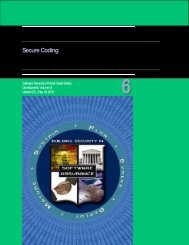Architecture and Design Considerations - Build Security In - US-CERT
Architecture and Design Considerations - Build Security In - US-CERT
Architecture and Design Considerations - Build Security In - US-CERT
You also want an ePaper? Increase the reach of your titles
YUMPU automatically turns print PDFs into web optimized ePapers that Google loves.
» Collaboration diagrams,<br />
» Statechart diagrams,<br />
» Activity diagrams, <strong>and</strong><br />
» Deployment diagrams.<br />
Some people in the SwA community feel that UML does not allow for the capture of security properties <strong>and</strong> does not include a<br />
model for use or abuse cases. Successful techniques for this purpose include threat modeling, data flow diagrams, abuse cases,<br />
<strong>and</strong> attack trees.<br />
Misuse/Abuse Cases – Misuse cases are similar to UML use cases, except that they are meant to detail common attempted<br />
abuses of the system. Like use cases, misuse cases require underst<strong>and</strong>ing the services that are present in the system. A use<br />
case generally describes behavior that the system owner wants the system to implement. Misuse cases apply the concept of a<br />
negative scenario—that is, a situation that the system's owner does not want to occur. For an in-depth view of misuse cases,<br />
see Gary McGraw’s “Misuse <strong>and</strong> Abuse Cases: Getting Past the Positive” at the <strong>Build</strong> <strong>Security</strong> <strong>In</strong> (BSI) portal at<br />
https://buildsecurityin.us-cert.gov/; a direct link is available under resources at the end of this section.<br />
Figure 2 - Misuse Case example (source: OWASP’s<br />
Testing Guide)<br />
Misuse cases help organizations see their software in the same light attackers do. Just as use-case models have proven quite<br />
helpful for the functional specification of requirements, misuse cases <strong>and</strong> use cases can improve the efficacy of eliciting security<br />
requirements. Guttorm Sindre <strong>and</strong> Andreas Opdahl extended use-case diagrams with misuse cases to represent the actions that<br />
systems should prevent in t<strong>and</strong>em with those that they should support for security <strong>and</strong> privacy requirements. There are several<br />
templates for misuse <strong>and</strong> abuse cases provided by Sindre <strong>and</strong> Opdahl. Figure 2 shows an example of a use/misuse case<br />
diagram from OWASP’s Testing Guide. The use case diagram demonstrates the actions that both the user <strong>and</strong> the application<br />
perform in the particular scenario. The misuse case diagram demonstrates the actions that can be taken by an attacker to hack<br />
into the system in the particular scenario. The two are linked together by arrows showing which of the attacker’s actions threaten<br />
the actions of the user/application as well as which of the user/application’s actions thwart the actions of the attacker. Making a<br />
diagram like this can point out possible security holes in the system.<br />
<strong>Architecture</strong> <strong>and</strong> <strong>Design</strong> <strong>Considerations</strong> for Secure Software 6
















